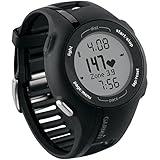The Benefits & Use of Heart Rate Monitor Watches
sport watches Tags: Benefits, Heart, Monitor, Rate, WatchesNo Comments »
Monitor Your Heart Rate to Ensure Maximum Results
Whether new to exercise or a seasoned veteran, the use of heart rate monitor watches during exercise can bring a new element of understanding and intensity to your exercise routine. Heart rate monitor watches continually measure your pulse as you exercise and help you stay within a predetermined heart rate range called the ‘target training zone’.
Although heart rate monitor watches have been in existence for some time, their value often goes unrecognized by fitness professionals and participants alike. This happens because there is a lack of guidance on how to use the feedback watches provide to achieve a specific goal. With just a basic understanding of Maximum Heart Rate (HRmax) and target training zones you can measure fitness levels, monitor progress, increase exercise intensity, and iathletic performance.
Determine Your Training Zone
In order to determine your training zone, you must first calculate your maximum heart rate (HRmax). HRmax is estimated by taking 220 and subtracting your age (220-age). Next, find the heart rate training zone that correlates with your fitness goals. The heart rate training zone or ‘target training zone’ is a high and low heart rate range based on a percentage of your HRmax.
Remember that working at a specific intensity will yield corresponding results. If you are new to exercise, start at with the low intensity training zone. Low intensity training zone will improve your cardiovascular function and build endurance, but to ultimately achieve your goals, you may need to jump up to the moderate or high intensity training zones.
Key Target Training Zones (% of max HR)
60-70%: Low intensity exercise.
70-80%: Medium intensity exercise.
80% +: High intensity exercise
The American Heart Association, whose guidelines are created for those with a goal of general health, recommends staying within 50 to 85 percent of your maximum heart rate. In contrast, ACSM Guidelines recommend intensities between 55% and 65% all the way up to 90% of HRmax. These recommendations are created for a range of people, from un-fit to extremely athletic. ACSM also suggests that de-conditioned individuals may experience improvements at exercise intensities of only 55% to 64% HRmax.
Remember, a well rounded exercise programincludes both aerobic exercise and strength training, but not necessarily in the same session. Your heart rate monitor will provide useful feedback for both types of exercise and allow you to create a program that motivates you to exercise regularly. Consistent, regular activity will provide more health benefits than sporadic, high-intensity workouts, so choose exercises you are likely to enjoy and that you can incorporate into your schedule. And always check with your physician before starting an exercise program.
Jes Reynolds is a fitness professional who has been studying health & fitness for over 12 years. In addition to actively participating in health, fitness and athletics, Jessica received a B.S. Kinesiology from Michigan State University. Her combined education and experience working with all types of individuals, from the physically or mentally handicapped to the elite athlete, allows her to understand both the scientific and behavioral aspects of weight loss, fitness and athletics.


































































